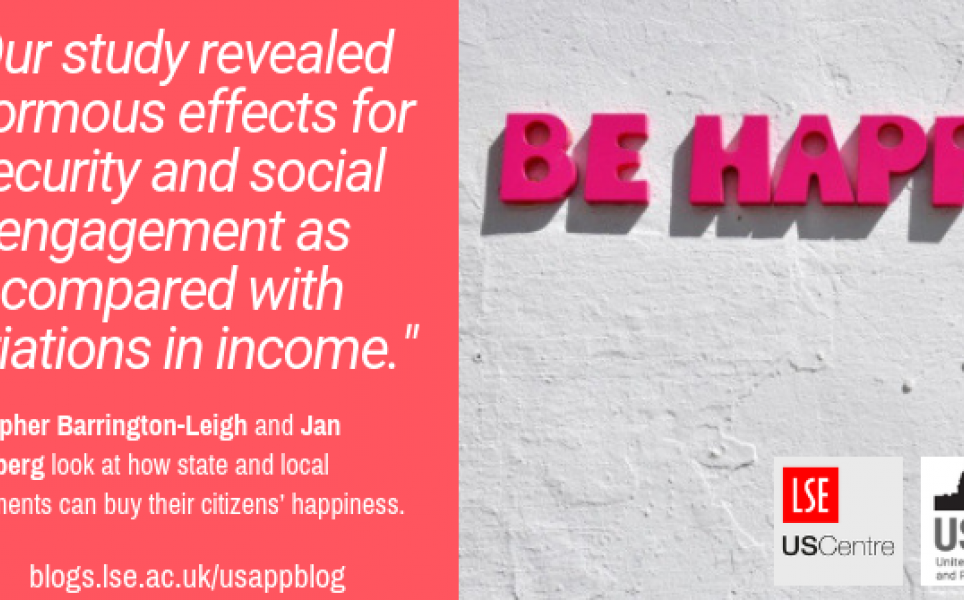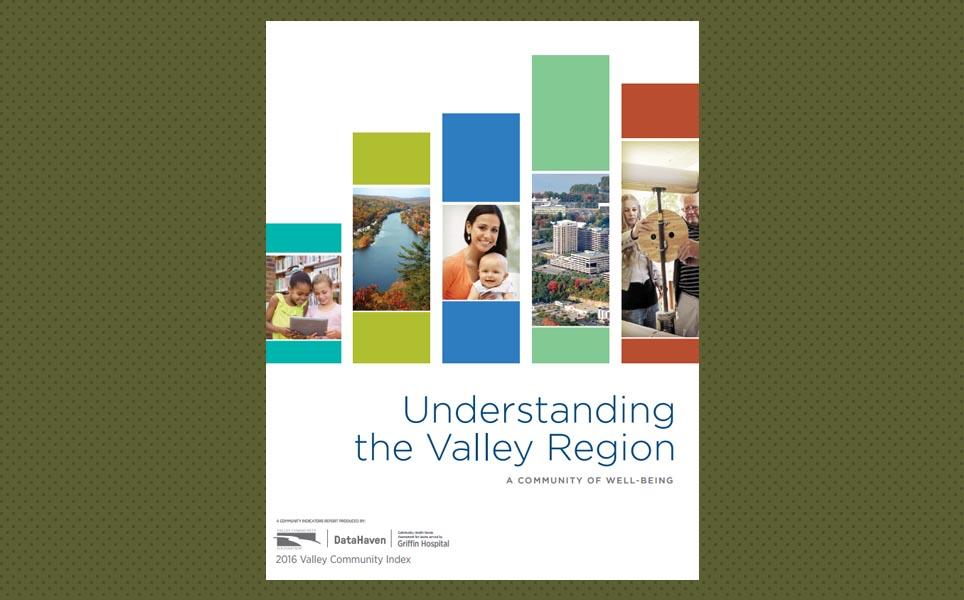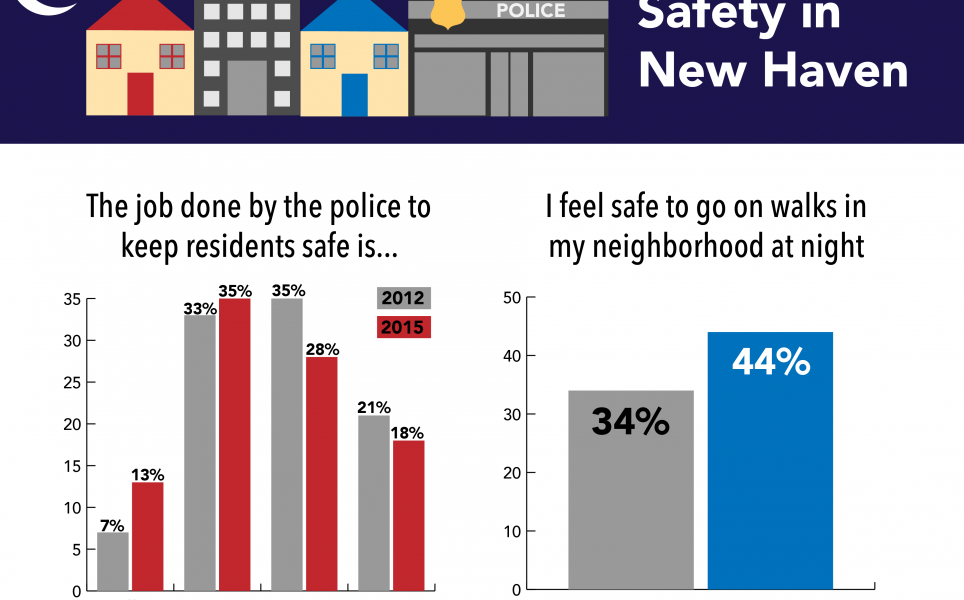Nearly 17,000 randomly-selected residents of all towns in Connecticut and adjacent sections of New York State participated in the 2015 DataHaven Community Wellbeing Survey, with in-depth interviews on quality of life, health, and happiness
NEW HAVEN, CT, November 23, 2015 – How happy are you? Have you seen a dentist lately? Is it safe to walk in your neighborhood? Is local government responsive to your needs? Do you need more education or training to advance in your current job? These are some of the more than 100 questions that nearly 17,000 representative residents answered as part of the 2015 DataHaven Community Wellbeing Survey.
DataHaven, a non-profit group leading the collection and study of neighborhood-level public data on key social and economic trends, announced the completion of the survey this week. It is believed to be the most intensive effort of its kind in the United States.
For the first time, this program has created a detailed portrait of social and economic conditions in towns throughout Connecticut and adjacent sections of New York State.
“The purpose of the DataHaven Community Wellbeing Survey is to produce the highest-quality, neighborhood-level information on issues that are most meaningful to local residents,” says Mark Abraham, Executive Director of DataHaven. “The initiative is helping to strengthen collaborations between dozens of organizations and agencies that are working together to measure social progress and improve population well-being at the statewide and local levels.” The metrics in the survey complement traditional statistics on topics such as employment, personal income, reported crimes, tax base, and industry output.
Seeing the potential impact of its results, over 50 of Connecticut’s leading foundations, hospitals, community institutions, and government agencies have supported the program this year. Major funders are located in Hartford, New Haven, Bridgeport, Stamford, Waterbury, New Britain, Norwalk, Danbury, Greenwich, Middletown, Derby, Bristol, Norwich, New London, Manchester and other cities. (See full listing below.)
"The Connecticut Council for Philanthropy along with over 50 other funding partners invested in the first ever statewide Community Wellbeing Survey, a scientific survey of the state’s entire adult population that will provide timely, powerful knowledge about our communities and enable us to better know the people and places we care about,” explained Maggie Osborn, President of the Connecticut Council for Philanthropy. “The deep commitment from eight Community Foundations – including Hartford Foundation for Public Giving, The Community Foundation for Greater New Haven, Connecticut Community Foundation, Fairfield County’s Community Foundation, Valley Community Foundation, Community Foundation of Greater New Britain, Community Foundation of Eastern Connecticut, and Main Street Community Foundation in particular – enabled this project to expand and collect data from over 16,000 in-depth interviews that will reveal strengths and challenges about the quality of life across Connecticut that will inform and shape the work of philanthropy."
“UNITED BY DATA”: ABOUT THE SURVEY
In a departure from most statewide and national surveys, the DataHaven program brings together existing grassroots efforts across the state – effectively unifying more than a dozen pre-existing regional or local surveys into a single, high-quality effort that now covers all areas in Connecticut. The power of the survey results was greatly enhanced both by the number of respondents, as well as by having the same questions being asked of respondents in many different areas.
DataHaven designed its 2015 Community Wellbeing Survey with the support of nearly 100 local government, academic, health-care, and community partners as well as a panel of epidemiologists and survey research experts. The 20-minute survey, conducted by the Siena College Research Institute (SRI) in Loudonville, New York, involved landline and cell phone interviews with nearly 17,000 randomly-selected adults throughout Connecticut and adjacent sections of Westchester County between April and October, 2015. (Weighted estimates from the survey carry an overall margin of error of +/- 1%).
For the first time, the DataHaven survey can provide neighborhood- and regional-level information not available from any other source on community vitality, health, family economic security, and individual happiness. Other topics such as civic engagement, transportation, housing, and employment – even satisfaction with government and community life – are included.
“Our experience with this survey was that people enjoyed answering these questions,” says Abraham of DataHaven. “They were answering questions about their own happiness and health, their family’s financial security, and how their communities and neighborhoods are faring. These questions show that we care about some of the most meaningful aspects of their day to day lives.”
According to Don Levy, Director of the SRI, “Working on behalf of DataHaven, we have developed the largest dataset of its kind – this survey offers an extensive look at the health, satisfaction, perception of neighborhood or community, access to medical care, economic strength, and personal safety of a representative sample of state residents, and includes robust samples by not only small geographic areas but also by age, race/ethnicity, education, and income.”
MEASURING WHAT MATTERS MOST: PRELIMINARY RESULTS AND TRENDS IN CONNECTICUT
In-depth interviews were completed with 16,219 randomly-selected adults in every Connecticut city and town. Although Connecticut does well when compared to national and international averages of health, income, and education (for example, ranking as the top state in the United States in the Measure of America’s Human Development Index), results from the DataHaven Community Wellbeing Survey demonstrate that disparities are still great, with a sizeable share of residents continuing to face significant barriers to economic success, safety, health, and other critical aspects of well-being.
To cite just a few examples from the more than 100 questions in the survey:
- 74% of men and 75% of women in Connecticut report feeling mostly or completely happy during the previous day. However, this measure varied widely by income, ranging from 53% among adults earning less than $15,000 per year to 89% among adults earning $200,000 or more. Similar to recent work conducted in the United Kingdom, the DataHaven Community Wellbeing Survey will allow researchers to combine this and other variables of subjective well-being with other items in the survey, in order to study the wide variety of factors that most impact quality of life throughout the state.
- Nearly one out of every twenty Connecticut adults (4.9%) continue to lack health insurance. This figure has been dramatically declining in recent years, but remains of concern to policymakers and within certain communities where rates remain higher than the statewide average. Within the Greater New Haven region, where the DataHaven Community Wellbeing Survey had been previously conducted in 2012, the uninsured rate fell from 10% in 2012 to 4% this year.
- Although official unemployment rates have fallen substantially since 2012, 14% of Connecticut workers are still considered “under-employed,” meaning that they have no job and would like to work or they are currently working part-time but would prefer to have a full-time job. Within the Greater New Haven region, the “under-employment” rate among workers fell from 21% in 2012 to 13% in 2015. Just under one-third of all adults are retired, disabled, or otherwise not in the workforce, so are not considered in these calculations.
- Sixty-six percent (66%) of Connecticut residents say that they are either doing alright or living comfortably when asked how they are managing financially these days. However, 11% are finding it difficult or very difficult, and an additional 21% say that they are just getting by. Additionally, many in Connecticut still struggle to afford food, adequate housing, and reliable transportation. One out of every ten adults identifying as white or Asian-American, and one out of every four adults identifying as African-American or Latino, reported that they did not have enough money to buy food for themselves or their family at some point during the past 12 months – in some cases, facing this situation almost every month of the year. About 6% of adults reported that they did not have enough money to provide adequate housing for themselves or their family, and 13% reported a lack of reliable transportation, at some point in the past year.
- Despite the challenges faced by many residents, across most neighborhoods, age groups, and population groups throughout Connecticut, four out of every five adults say that they are satisfied with where they live, and a similar proportion believe that their area is staying the same or getting better. Residents of some urban neighborhoods have substantially lower rates of overall satisfaction with where they live as well as much greater concerns about government responsiveness, police effectiveness, and public services. On the other hand, cities such as Stamford, Norwalk, Bridgeport, and New Haven have relatively higher proportions of adults who are optimistic that their neighborhood is improving, and residents of higher-income neighborhoods within these city centers are in some cases significantly more satisfied with local quality of life than the average resident.
“The survey shows that virtually every aspect of life, from the availability of goods and services and governmental responsiveness to job prospects and the probability of being victimized, varies substantially by income. But, in some cases it is more than just how much money an individual household earns but rather the community in which one lives that divides the state into distinct clusters,” according to Levy. “These worlds, while geographically interspersed, are clearly divided. For example, in ‘wealthy’ towns, over ninety percent of residents rate the job done by the police as excellent or good, while nearly half of residents in the ‘urban cores’ rate the police’s efforts as no better than fair or poor. The data demand careful consideration by all Connecticut policymakers, elected officials, civic and cultural leaders as well as the general population. The 2015 DataHaven Community Wellbeing Survey provides Connecticut with an in-depth look at the quality of life, local services and in some cases the hurdles that some in the state face on a daily basis,” Levy stated.
SHARING THE RESULTS
Detailed statewide and local results will be made available to the public over the coming weeks, allowing regions, clusters of towns, and all of Connecticut’s larger towns the ability to look at data for their population separate and apart from the balance of the state. Due to the complexity of this first-of-its kind dataset, data and additional analyses will be posted on the DataHaven website and shared on an ongoing basis throughout the next several months, both by DataHaven as well as each of its community-based or statewide partners. Please contact DataHaven for details or to request information.
Additional analyses of the DataHaven Community Wellbeing Survey will be published in a series of regional and statewide reports throughout 2016. As one example, DataHaven will be updating and significantly expanding its Community Index, a nationally-recognized study that has been used extensively by governments, community organizations, journalists, teachers, and researchers, in mid-2016. Local public health agencies and hospitals throughout the state will be using the survey’s detailed data on health-related issues, such as healthcare access, smoking, e-cigarette use, and chronic disease, to publish community health needs assessments.
“With such a detailed snapshot, state and local community leaders will be able to better serve the well-being of their communities. For 25 years, DataHaven has been supporting data use across local, state, and national programs. The information released over the coming weeks and months will be of great use to local residents and initiatives that are collaborating to improve the quality of life in Connecticut,” noted Abraham.
FUNDERS FROM EVERY CORNER OF CONNECTICUT
A list of funders of DataHaven’s 2015 Community Wellbeing Survey follows. This is a partial list, according to Abraham, yet it indicates the extent of participation across Connecticut.
Foundations and Philanthropy
- The Community Foundation for Greater New Haven
- Hartford Foundation for Public Giving
- Fairfield County’s Community Foundation
- Community Foundation of Greater New Britain
- Connecticut Community Foundation
- The Saunders Fund at Connecticut Community Foundation
- Valley Community Foundation
- The Bassett Family Fund at Valley Community Foundation
- Katharine Matthies Foundation
- Connecticut Health Foundation
- Community Foundation of Eastern Connecticut
- Main Street Community Foundation
- Connecticut Council for Philanthropy
- United Way of Greater New Haven
- United Way of Coastal Fairfield County
- United Way of Greater Waterbury
- Valley United Way
- NewAlliance Foundation
- Carolyn Foundation
Health Care
- Yale-New Haven Hospital
- Bridgeport Hospital
- St. Vincent’s Medical Center
- Stamford Hospital
- Greenwich Hospital
- Waterbury Hospital
- Saint Mary’s Hospital
- Saint Francis Hospital and Medical Center
- Johnson Memorial Medical Center
- Lawrence + Memorial Hospital
- Danbury Hospital
- Norwalk Hospital
- Griffin Hospital
- Middlesex Hospital
- Yale Medical Group
- StayWell Health Center
Government / Agency / Community
- Connecticut Housing Finance Authority
- Connecticut’s Legislative Commission on Aging
- Bridge to Success Community Partnership
- Thames Valley Council for Community Action
- Capitol Region Council of Governments
- Workforce Alliance
- City of Bridgeport Health Department
- City of New Haven Health Department
- City of Waterbury Health Department
- Ledge Light Health District
- Eastern Highlands Health District
- Northeast District Department of Health
- Stratford Health Department
- Fairfield Health Department
- Chesprocott Health District
- Pomperaug Health District
- Uncas Health District
- Manchester Health Department
- Office of the President, Trinity College
- Center for Urban and Global Studies, Trinity College
- University of Hartford
- United Community and Family Services
Plus more public and private partners not listed above
###
For more details and interviews, contact Mark Abraham, 203.500.7059, info [at] ctdatahaven.org
About DataHaven
DataHaven is a non-profit 501(c)3 organization, directed by Mark Abraham, with a 25-year history of public service to Greater New Haven and Connecticut. DataHaven’s mission is to improve quality of life by collecting, sharing, and interpreting public data for effective decision-making. Since 1992, DataHaven has worked with area organizations to develop reports and tools that make information more useful to the community. DataHaven maintains extensive economic, social, and health data, including information collected through the DataHaven Community Wellbeing Survey in 2012 and 2015. DataHaven is a formal partner of the National Neighborhood Indicators Partnership, a collaborative national effort by the Urban Institute and approximately 40 local partners to further the development and use of neighborhood information systems in local policymaking and community building.
About the Siena College Research Institute
Founded in 1980, the Siena College Research Institute, directed by Donald Levy, Ph.D., conducts political, economic, social and cultural research throughout the United States. SRI, an independent, non-partisan research institute, subscribes to the American Association of Public Opinion Research Code of Professional Ethics and Practices. For more information, please call Don Levy at 518-783-2901.
###









